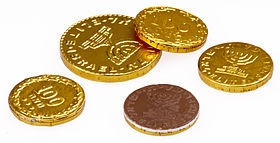
An important Hanukkah tradition, gelt is either money given as a gift on Hanukkah or, more commonly today, a coin-shaped piece of chocolate. Gelt is generally given to children, though, in the past, it was an adult tradition as well. It may be given every night of Hanukkah or only once.
When it is in the form of chocolate candy, gelt is often used to make bets in the dreidel game. When it is in the form of real money (which is unusual today) it may be used for purchases or, ideally, for charitable causes. Today, the chocolate coins are available in gold or silver foil and given to children in small mesh bags on Hanukkah.
The word gelt is the Yiddish word for “money” (????). There are several competing theories regarding the origins of the tradition of giving children money on Hanukkah.
According to Smithsonian Magazine, the very first mention of gelt is ancient: “the roots of gelt, or ‘money’ in Yiddish, are in the first Jewish minted coins, in 142 BCE, after the Maccabees gained independence from the Syrian king. The coins were stamped with an image of a menorah.”
The most likely source for the modern tradition of gelt-giving, however, comes from the Hebrew word for Hanukkah. Hanukkah is linguistically connected to the Hebrew word for education, hinnukh, which led many Jews to associate the holiday with Jewish learning. In late medieval Europe, it became a tradition for families to give their children gelt to give to the local Jewish teacher on Hanukkah as a gift to show appreciation for education. Eventually, it became customary to give coins to the children as well to encourage their Jewish studies.
By the end of the 1800s, the famous author Sholem Aleichem was writing about gelt as an established tradition. In fact, he describes a pair of brothers going from house to house collecting Hanukkah gelt in much the same way that contemporary American children collect candy during Halloween.
Today, most families give their children chocolate gelt, though some continue to pass out actual monetary gelt as part of their Hanukkah celebrations. Generally, children are encouraged to donate this money to a charity as an act of tzedakah (charity) to teach them about the importance of giving to those in need.
Credit : Learn Religions
Picture Credit : Google




